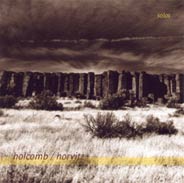Robin Holcomb/Wayne Horvitz
Solos
(Songlines)
Calling
the piano an element that's of paramount importance for the music of both
Robin Holcomb and Wayne Horvitz can sound quite banal if one thinks of the
compositional process, but not-so-banal after all if one thinks of the performance
area. The piano has always been a big part of the aural landscape of Holcomb's
albums, from her (definitely underappreciated) albums of songs (the most recent,
The Big Time, was released in 2002), to works such as Little Three (1996),
where long compositions speak through solo piano. Maybe the most "psychedelic"
of modern (but, fortunately, not "post-modern") keyboard players,
Wayne Horvitz's name immediately recalls to the mind the Hammond B-3, the
Yamaha DX-7, the Fender Rhodes and the Clavia Nord Lead, not the acoustic
piano. So listening to an album where the two play (separately) solo piano
can be a nice and stimulating experience; a lot of variety, too: composition
and improvisation; brief and long tracks; originals and remakes. Very good
recorded sound, an excellent piano (it's a Steinway D - but listen to the
way some notes played by Horvitz in the closing track, Crispin And Lisa's
Duet, almost seem to come from a Rhodes!), a "double layer" album:
CD and SA-CD.
The
first track, Reno, is a good example of the quasi-neoclassical shade of Holcomb's
world, while the following tracks, Tired and Armageddon (the latter a composition
by Wayne Shorter) show Horvitz's usual pronunciation, where it's not impossible
to see Otis Spann behind Monk's Functional; just a bit later, Joanna's Solo
sounds as if implicitly offering some orchestration choices (Doug Wielselman?).
The Pleasure Of Motion presents Holcomb in a rare free improvisation, maybe
with a faint echo of Cecil Taylor. The only long track of the CD, Before The
Comet Comes is a Holcomb composition, complex and with multiple themes as
it's usual for her (but listen to the almost-Horvitz echoes starting at 10'58").
The other tracks follow the same script but are not less beautiful for this:
the more "jazzy" Horvitz can be heard in Stars Fell On Alabama and
Buttermilk Hill, while the two tracks called Interpretation show him in his
improvising mode; The Road To Zamora (those who remember Todos Santos, raise
your hands) and Up Do make us connect with Holcomb's past. The already-mentioned
Crispin And Lisa's Duet is a perfect close.
In
closing, we can define Solos as that rare example of an album that's not at
all difficult to listen to but that, given time, can reveal a lot: discretely,
with intelligence.
Beppe Colli
© Beppe Colli 2005
CloudsandClocks.net | June 5, 2005











